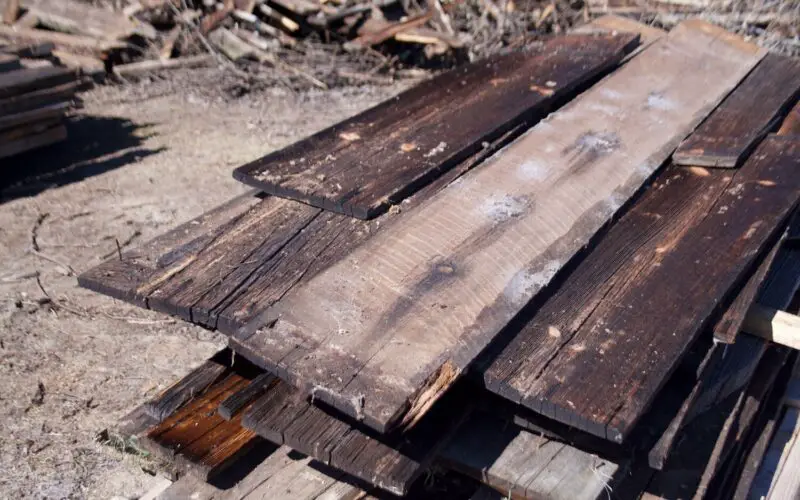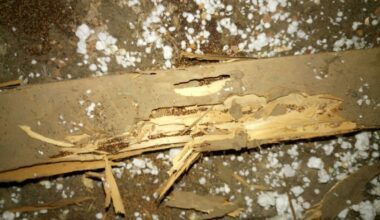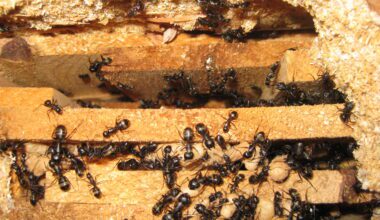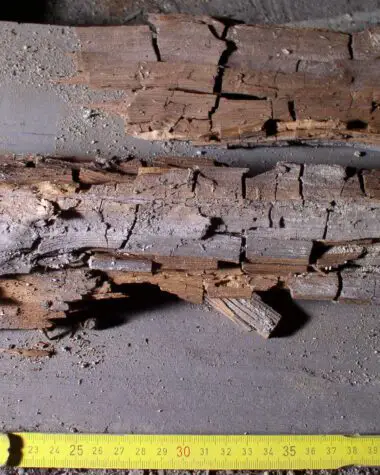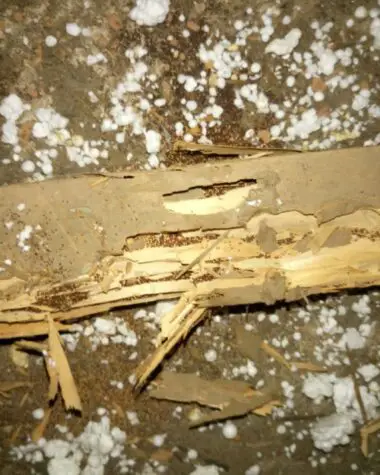The use of reclaimed wood to make furniture and home décor items has become extremely popular nowadays. Reclaimed wood is easy to acquire and is the perfect thing to indulge your latest carpentry addiction.
Reclaimed wood is also an excellent way to recycle old wood rather than burning or destroying it. Depending on your style, you can turn your old wood into something useful and unique. It gives the wood a new purpose while creating a magnificent piece of furniture for your home.
But before you start using reclaimed wood straightaway for your upcoming carpentry project, it is very important to rid it of any bugs that might be lingering. Reclaimed wood, depending on where it spent its previous life, can be home to a myriad of bugs.
If these bugs are not eradicated completely, over time, they will destroy this reclaimed wood and even affect other furniture in your home. Here are useful tips to properly treat and restore your reclaimed wood.
What Kind of Bugs Can Be Found in Reclaimed Wood?
Several bugs thrive in old wood. Once infestation begins, they plant eggs and larvae that are too small to notice. So it is vital to properly check and treat your reclaimed wood before using it again.
Here’s a list of the most common wood-infesting insects that may secretly hide in your reclaimed wood.
Termites
Termites are probably the most common of all insects that reside within wooden structures. These pesky insects cause billions of dollars worth of damage to wooden structures worldwide. Each species might damage a particular type of wood.
Some termites like moist and humid surroundings, while others prefer dry wood. These specific environmental conditions best suit their survival and reproduction. If you want to easily spot and catch these pests, you can start looking for signs.
Here are some of the common warning signs when examining reclaimed wood, which will tell you whether there are termites inside:
- Sighting insects that resemble white ants.
- Pencil-sized openings to tubes made out of mud inside the wood.
- Worker termites shed their wings. So if you see wings around the wood, you know it has termites within.
Carpenter ants
Carpenter ants, like termites, burrow into the wood and weaken the structure significantly. They exhibit the same symptoms as termites, and the detection mechanism is also the same. In addition to moist conditions, they prefer molding wood to a greater extent.
Wood boring beetles
Wood boring beetles also pose a significant threat to the integrity of the wood and may even harm the people around your home furniture. This is because of the gestational periods of beetle eggs.
Beetle eggs may live inside the wood for years before hatching if left unnoticed. To catch these critters, look for tiny holes in the surface of the wood. Female beetles chew through the wood and make these holes where they can safely lay eggs.
Treating Reclaimed Wood
You can employ several methods to treat reclaimed wood and rid it of bugs. Some methods are industrial, while others can be easy-to-follow using reclaimed wood. Here’s a step-by-step guide to treating your recycled wood.
Step 1
Clean the wood thoroughly. The wood should be devoid of all dirt, dust, and any residual nails. This will greatly help in ensuring proper sanitation during the treatment process.
Step 2
You can start killing the bugs and insects living inside the wood. You can choose one of the following methods to treat reclaimed wood and rid it of bugs.
Using a Wood Kiln:
Reclaimed wood, besides possibly housing bugs, invariably contains excessive moisture inside. Treating the reclaimed wood in the kiln will ensure that this moisture is removed, and in that process, all the bugs will also be destroyed.
A kiln is basically a furnace in which the wood is left inside to dry. The duration for which the wood stays inside the kiln depends on the amount of moisture the wood contains. Since heat is applied to remove the moisture, it serves a dual purpose of killing pests as well.
Pressure Treatment:
Some chemicals are used during a pressure treatment for wood. The chemicals and the wood are kept in a pressurized container for a period of time. This ensures that all the bugs and insects inside are killed. This also ensures that bugs do not infect the wood in the future.
But, the caveat of using pressure treatment is the wood no longer remains food grade. The chemicals used in the treatment can be quite harmful if ingested. So, if the purpose of acquiring reclaimed wood is to make items that will be around food, then this is probably not a good idea.
Plastic Wraps:
You can wrap your piece of wood in a heavy plastic sheet and leave it in the sun for a few days. The plastic wrap acts as insulation. The bugs and insects within the wood will either die or come out of the wood to escape.
You can simply unwrap the wood and brush off the dead insects and bugs. Though this does not guarantee completely removing all the bugs, this method can still eliminate most of the critters.
Wood Fumigation:
To kill the bugs on the surface of the wood, wrap the wood in plastic and apply pesticide or spray. The wrap will keep them from escaping to other places and eventually kill them.
Step 3
Once the wood is treated to ensure no bugs are inside, you can use certain chemicals to treat reclaimed wood. These chemicals can permanently kill bugs in the wood and prevent possible re-infestation.
Borax:
Borax is one of the most common products to remove bugs in the wood. Although borax is a chemical, it does not harm humans or pets. But it has a deadly effect on insects and bugs. This method is very simple and only requires borax and clean water.
Borax and water mixture must be applied to the wood, and the wood must be soaked in the mixture within enough time. This will completely kill all the bugs living inside the wood. The best thing about borax is that its usage has no bearing on the finishing of the wood.
Timbor:
After the wood has been treated with Borax, it is generally a good idea to give it a coating of Timbor. Again, the wood must soak for 72 hours in the timbor solution. Extra care must be taken to wash Timbor off the wood since it leaves behind a white mark from its residue.
Timbor is a proven and tested efficient coating for reclaimed wood to prevent future re-infestation of wood-destroying pests, such as insects and fungi. However, proper maintenance of your wood projects is still required to avoid possible infestation problems.
Step 4
After cleaning, sanitizing, and treating your reclaimed wood, it can now be reused for many purposes and creative projects. You can search online for guides in making DIY reclaimed wood projects or invent and explore your own.
If you are looking for your first project with your reclaimed wood, here’s a sample wooden table you can try using your restored wood and step-by-step instruction.
How to Build a Tabletop from Reclaimed Wood
You can’t just throw wood away, especially wooden furniture. You can reuse and reclaim wood from old furniture to make new ones. If you have old, forgotten furniture in your attic or garage, then maybe it’s time to give them a new lease on life.
So, why buy a new table when you can build one from reclaimed wood? It’s cheaper, easier, and no doubt more fun when you recycle. Here is a guide to help you build a tabletop from recycled wood.
You will need the following materials:
- Reclaimed Wood (board feet dependent upon table size required)
- Table Legs
- Sand Paper
- Steel Wool
- Wood Screws
These tools will greatly help:
- Drill/Screwdriver
- Hammer
- Pliers (optional)
- Gloves (optional)
- Saw Horses
- Rip Saw (with wood blade)/Hand Saw
Instructions
Here’s a step-by-step guide to creating your tabletop from recycled wood. From choosing the right wood piece to finishing your DIY furniture.
Step 1 – Look for salvaged wood.
Look for places where you can find reclaimed wood if you don’t have one. Instead of just looking for the cheapest piece of wood, look for pieces with potential. Look for large doors, old farm tables, and old working tables.
Bring gloves because you will get dirty as you look for the best deals. The next thing to consider is hiring a truck or a van if you don’t have one because you might end up hauling your reclaimed wood home if the seller does not have delivery options.
Step 2 – Remove nails and other hardware.
Time to clean up your wood, and cleaning starts with removing all visible hardware, including nails, screws, bolts, and hinges in a wooden door. Pull with the grain of the wood to prevent damaging your reclaimed treasure.
Step 3 – Cut the wood to length.
Cut the wood to a length according to the number of people you will accommodate at the table. For an 8’ table, you can seat about 8 people. Consider the size of the seats that you will use as well.
Now, line up the pieces of wood you will use just like the finished product would look. Some of the pieces may require more effort. This is the time to shape them up before you assemble your table. But you don’t have to worry about this step if you use one solid piece like a door or a farm table.
Step 4 – Assemble your table.
Now that the pieces for your project are all set, it’s time to assemble it. You may use screws you readily have, or you can use new ones. Use sturdy screws. The sturdier the screws, the stronger your table will be.
Step 5 – Install table legs.
You can make your own table legs, but you can also purchase one from a supplier. A good option is to use table legs from old and discarded tables. Just make sure that these are in good shape.
Use strong and long screws to install these on your table. Lastly, don’t forget to check if everything is at the right level after installation. This will ensure your table is steady when placed for use.
Step 6 – Finish your table.
Use sandpaper, steel wool, or an orbital sander to finish your table. A few sandpapers followed by steel wool is a good way to remove all dirt and paint to smoothen the table’s surface. After exposing clean and new wood, you can wax, seal, or leave it.
You may also use paint. Make sure you apply the primer first, followed by a good coat of paint. Let your table dry well before use. Now, you have your own table made from reclaimed wood!
Conclusion
Save money by turning old wood into creative DIY wood projects like a cozy tabletop. It is very easy to do, and even beginners in woodworking can achieve it. You only need to follow a reclaimed wood’s proper sanitation, treatment, and restoration process.
With a few materials and the help of tools, you are ready to get all the woodworking done. For better results, ensure your reclaimed wood is completely pest-free and properly maintained with long-lasting coating and furnishing.
You can browse detailed guides online to learn more about wood treatment and restoration using chemical and natural methods to preserve your wood. If you want to avoid pests invading your precious reclaimed furniture, help is also available to prevent and eliminate these critters.
Discover more about wood infestation and determine its causative agents, warning signs, and other relevant tips to help secure your woodwork.
